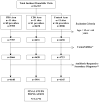A cluster randomized trial of decision support strategies for reducing antibiotic use in acute bronchitis
- PMID: 23319069
- PMCID: PMC3582762
- DOI: 10.1001/jamainternmed.2013.1589
A cluster randomized trial of decision support strategies for reducing antibiotic use in acute bronchitis
Abstract
Background: National quality indicators show little change in the overuse of antibiotics for uncomplicated acute bronchitis. We compared the effect of 2 decision support strategies on antibiotic treatment of uncomplicated acute bronchitis.
Methods: We conducted a 3-arm cluster randomized trial among 33 primary care practices belonging to an integrated health care system in central Pennsylvania. The printed decision support intervention sites (11 practices) received decision support for acute cough illness through a print-based strategy, the computer-assisted decision support intervention sites (11 practices) received decision support through an electronic medical record-based strategy, and the control sites (11 practices) served as a control arm. Both intervention sites also received clinician education and feedback on prescribing practices, as well as patient education brochures at check-in. Antibiotic prescription rates for uncomplicated acute bronchitis in the winter period (October 1, 2009, through March 31, 2010) following introduction of the intervention were compared with the previous 3 winter periods in an intent-to-treat analysis.
Results: Compared with the baseline period, the percentage of adolescents and adults prescribed antibiotics during the intervention period decreased at the printed decision support intervention sites (from 80.0% to 68.3%) and at the computer-assisted decision support intervention sites (from 74.0% to 60.7%) but increased slightly at the control sites (from 72.5% to 74.3%). After controlling for patient and clinician characteristics, as well as clustering of observations by clinician and practice site, the differences for the intervention sites were statistically significant from the control sites (P = .003 for control sites vs printed decision support intervention sites and P = .01 for control sites vs computer-assisted decision support intervention sites) but not between themselves (P = .67 for printed decision support intervention sites vs computer-assisted decision support intervention sites). Changes in total visits, 30-day return visit rates, and proportion diagnosed as having uncomplicated acute bronchitis were similar among the study sites.
Conclusions: Implementation of a decision support strategy for acute bronchitis can help reduce the overuse of antibiotics in primary care settings. The effect of printed vs computer-assisted decision support strategies for providing decision support was equivalent.
Trial registration: clinicaltrials.gov Identifier: NCT00981994.
Figures




Comment in
-
Antibiotic Prescribing for acute respiratory infections--success that's way off the mark: comment on "A cluster randomized trial of decision support strategies for reducing antibiotic use in acute bronchitis".JAMA Intern Med. 2013 Feb 25;173(4):273-5. doi: 10.1001/jamainternmed.2013.1984. JAMA Intern Med. 2013. PMID: 23318503 No abstract available.
References
-
- Gonzales R, Bartlett JG, Besser RE, et al. Principles of appropriate antibiotic use for treatment of uncomplicated acute bronchitis: background. Clinical Practice Guideline, Part 2. Ann Intern Med. 2001;134(6):521–9. - PubMed
-
- Gonzales R, Bartlett JG, Besser RE, et al. Principles of appropriate antibiotic use for treatment of nonspecific upper respiratory tract infections in adults: background. Clinical Practice Guideline, Part 2. Ann Intern Med. 2001;134(6):490–4. - PubMed
-
- Nadeem Ahmed M, Muyot MM, Begum S, Smith P, Little C, Windemuller FJ. Antibiotic prescription pattern for viral respiratory illness in emergency room and ambulatory care settings. Clin Pediatr. 2010;49(6):542–7. - PubMed
Publication types
MeSH terms
Substances
Associated data
Grants and funding
LinkOut - more resources
Full Text Sources
Other Literature Sources
Medical

